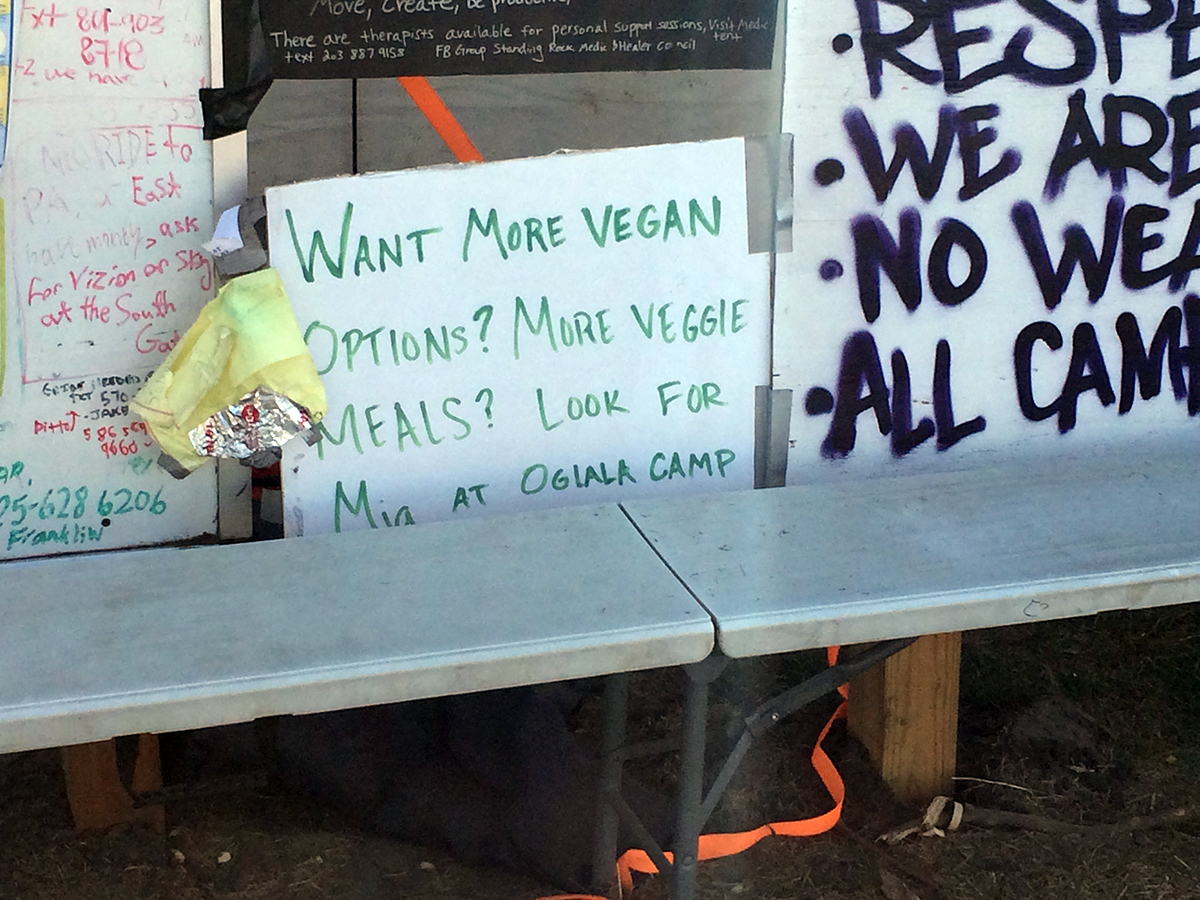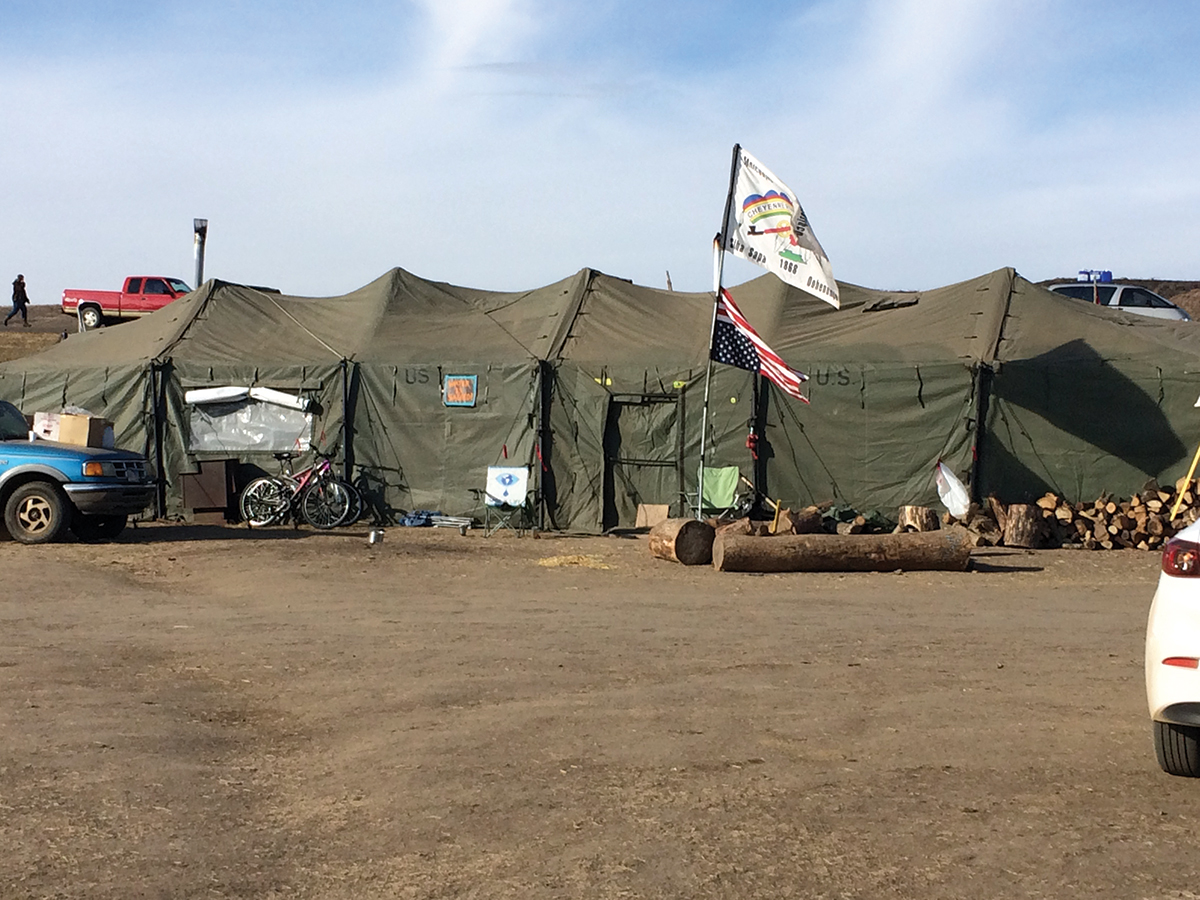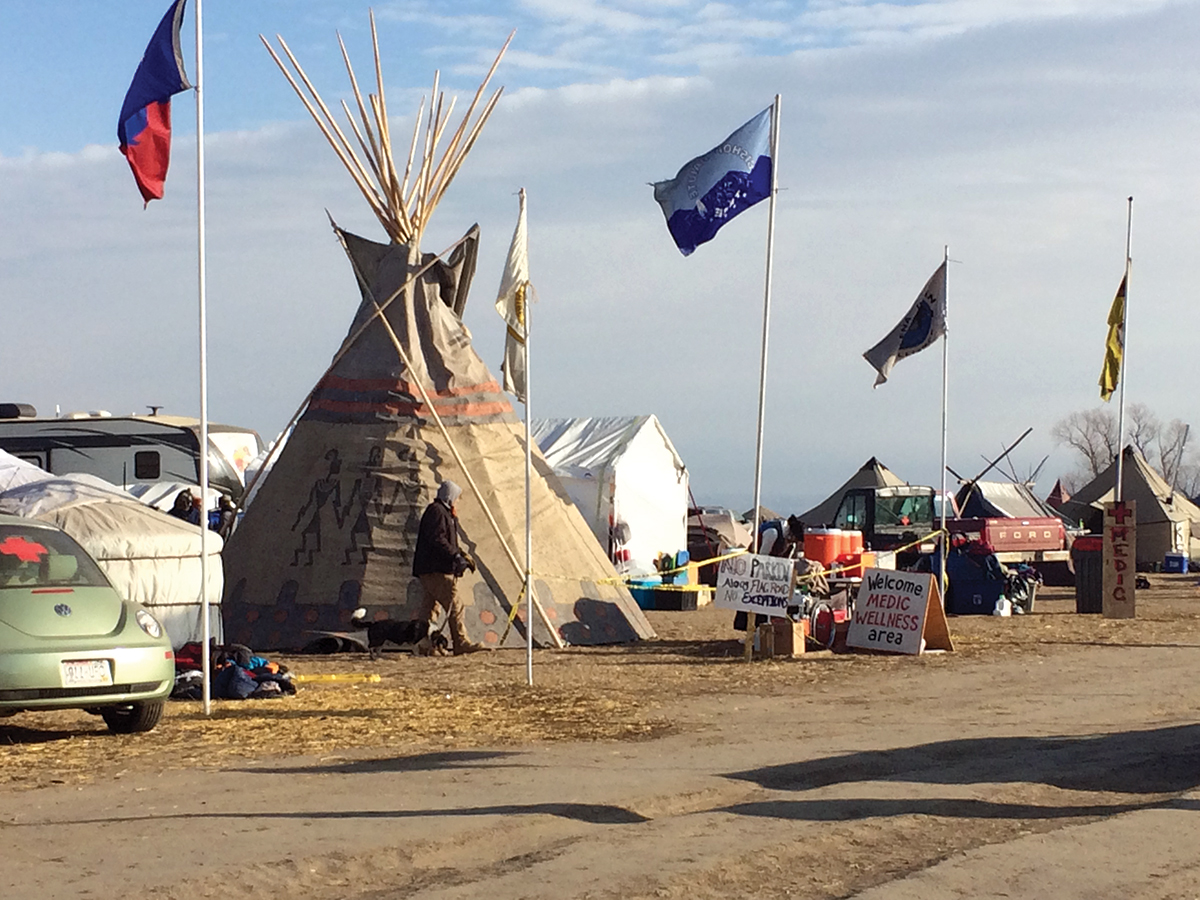Cannon Ball, N.D.
Driving near the Sacred Stone protest camp—ground zero of the effort to stop the Dakota Access oil pipeline from crossing the Missouri River—you meet a peculiarly balanced set of restrictions. To the north, the Morton County sheriff, with the help of the North Dakota National Guard, has set up a roadblock. Motorists coming towards the camp from that direction are stopped by armed officers who tell them to reroute around Highway 1806 because of a bridge that has not yet passed a safety inspection.
Motorists approaching the camp from the south, meanwhile, are stopped by self-appointed protest security forces who have kept the dark sunglasses but lost the bulletproof vests. They don’t give a reason to the drivers they stop.
Coming down the rolling hills towards the river bank, the camp is bounded by the water on one side and fencing on the other three. Where Highway 1806 passes the camp, the protesters have erected a permanent guardhouse. Cones block off the road, forcing cars that are not allowed into the camp to turn around. At the gate, three burly Native-American men interrogate the occupants of each car. A sign posted behind them warns “no photography.” (Most of the journalists allowed to enter are required to have an escort at all times.)
Why do liberal collectivist utopias feel so statist? Waiting in line to enter the camp, I can’t help but wonder. At first glance, Sacred Stone combines the misery of a refugee camp with the guarded nature of a dictatorship. One of the men comes up to my window, suspicious of my reasons for coming. I try to appear as naïvely helpful and wonderingly curious as possible and in the end, he decides I can be allowed in.
As I start to walk around the camp, I can’t shake the feeling that for all of its claims of community—of solidarity with the Sioux Nation against the U.S. Army Corps of Engineers and corporate power—the underlying spirit of the camp is one of rules enforced by unspecified, yet unpleasant means.
I’ve missed the morning orientation meeting for new camp-dwellers, but a large plywood sign clues me in on some of the other rules of the camp: “‘isms’ have no place here,” it warns. “No weapons.” For Direct Action Protesters (who volunteer to harass law enforcement on a more intimate level), there are more rules.

Camp kitchens offer free meals, but those with restrictive diets may need to look for help elsewhere. (Photo credit: Erin Mundahl)
Anarchy, this is not. At the same time, it can’t really be described as orderly. To try to spread information through the camp, the organizers have erected a series of whiteboards near the entrance. They are filled with phone numbers and first names linked to offers of a seat in a car to California, a note from a man who wants a dog, a woman willing to cook vegan meals, and someone looking for a ride to the airport.
The camp sprawls in all directions, a dusty collection of teepees, camping tents, semipermanent structures, and, ironically, green Army surplus tents, some of which still have “U.S.” stenciled on them. Nothing was laid out in any particular order, which means that without natural landmarks, the further one gets from the road of flags, the more of a hodgepodge of mismatched canvas dwellings it becomes.
I’m not the only wanderer. Despite talk of prayers and work groups, most people have too much time on their hands. They wander between the tents and teepees. There’s a stream of men in their twenties wearing cargo shorts and dreadlocks, middle-aged women with crazy hair, flowing skirts, and sensible boots, and young women wearing the designer versions of the above. To the chagrin of North Dakota education officials, whole families have come, piling the kids into retrofitted school buses to come to the camp for an education that qualifies as home schooling only in the vaguest sense of the term.

Protesters live in a variety of temporary and semi-permanent structures, including tipis, camping tents, and green army tents. (Photo credit: Erin Mundahl)
This summer the camp boasted of running its own school. None of the children I see is in the schoolroom, though. Three sons of this activist class, all around 10 years old, are squabbling over a snack. It’s a squirming, poking mess of each trying to get a piece of what turns out to be pepperoni. Just when things seem to have been resolved, one turns in accusation.
“Hey! You can’t have pepperoni!” he cries. “You’re vegetarian!”
It’s a J’accuse moment.
Although “Mia” can set you up with more vegetarian options (per the whiteboard), restrictive diets are only one of the many small ways in which camp life is made more difficult than it might otherwise be. It isn’t enough to feed, clothe, and shelter 3,000 people who decided to camp out in North Dakota in the winter. Some of them want vegan meals and natural medicine. Although ostensibly united against an oil pipeline, their attitude is more protest chic. Already some supporters have taken to Facebook and Twitter to complain that “it feels like a budding Burning Man in some areas of camp” and “nobody wants to hear your songs with your guitar.”
After being at the camp for a few hours, I realize I’d quickly lost track of the purported reason for all the tents: the waters of the Missouri River. Despite being the focus of the protest, the river itself was tangential to the inwardly focused camp life.
The camp is in a constant state of flux, a sea of nylon and woodsmoke and tents and cars, which move regularly. Everyone I ask for directions is friendly and unable to help. Sorry, they just got here. They are mostly the same sort of people I saw at the Bismarck airport on my way here—white, middle-class, college-educated, and caring. They want to help and after their week is up, they’ll pack up and go home. As their numbers grow, they are shifting the tone of the gathering. Rather than the prayers and ceremonies that many may have expected to see, there are girls just out of college taking selfies as they chop firewood.

Camp volunteers have assembled a medic area offering herbal remedies, acupuncture, and other medical care. More serious injuries are taken to hospitals in Bismarck or Mandan. (Photo credit: Erin Mundahl)
Jen, a woman in her late twenties, is waiting next to her Subaru-based campsite with her dog, while her boyfriend helps to construct permanent buildings elsewhere in the camp. (She is the third woman I’ve met so far with a builder boyfriend.) They just arrived from Colorado, full of enthusiasm to save the river. When I ask her, she admits she isn’t really sure where it is. “Somewhere over there,” she says, gesticulating generally.
There is something vaguely zen about coming so far for the river, only to be unable to find it. She, the boyfriend, and the dog had driven for hours to reach it, to be able to say that they had been here and had helped. They were joined by those who came by car, motorhome, and airplane. All to stop the pipeline.
And all of these people? How did they get here? For the most part by burning fossil fuels.
There is no avoiding it: Sacred Stone is a protest with a large carbon footprint. Given the rough terrain, pickup trucks are the most useful vehicles, and the camp is filled with the deep purr of diesel engines. That’s the lifeblood of rural America. Without cars, there is no way to get around. And so the camp is packed with cars and trucks—and a disproportionate number of Subarus—with license plates from as far away as Alaska. Washington and Colorado plates are especially common. Those who didn’t drive flew and then begged or hitchhiked their way the last 45 miles to the camp. They came to have their moment, to stick it to the man, and to demonstrate that Big Oil can’t just trample native rights.
Oil runs the cars and planes they took to get here. It powers the generators that provide their electricity. Water is life, but oil is pretty darn useful, it seems.
Erin Mundahl is a reporter for InsideSources.
